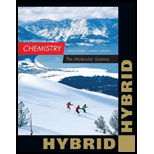
Concept explainers
Interpretation: The mass fraction, weight percent and
Concept introduction:
Mass fraction: The mass of a single solute divided by the total mass of all solutes and solvent in the solution.
Weight percent: The mass of one component divided by the total mass of the mixture, multiplied by
Answer to Problem 122QRT
Explanation of Solution
Table salt:
- The Mass fraction:
Given information as: Mass of table salt is
Mass fraction of table salt
Hence, the mass fraction of table salt is
- The Weight percent:
Given information as: Mass of table salt is
The weight percent of table salt is calculated as shown above. Hence, the weight percent obtained is
As known,
Then,
Therefore, ppm of solute is
Glucose:
As known,
Then,
Therefore, weight percent of solute is
- The Weight percent:
Given information as: Mass of glucose is
The weight percent of glucose is
Mass fraction of glucose is
Mass of water is
Methane:
- The Weight percent:
Given information as: Mass of methane is un-known and pure water is
The mass of methane is
- The Mass fraction:
Given information as: Mass of methane is
Mass fraction of methane
Hence, the mass fraction is
As known,
Then,
The ppm of solute is
Therefore,
Want to see more full solutions like this?
Chapter 13 Solutions
Chemistry: The Molecular Science, Hybrid Edition (with OWLv2 24-Months Printed Access Card)
 Chemistry: The Molecular ScienceChemistryISBN:9781285199047Author:John W. Moore, Conrad L. StanitskiPublisher:Cengage Learning
Chemistry: The Molecular ScienceChemistryISBN:9781285199047Author:John W. Moore, Conrad L. StanitskiPublisher:Cengage Learning World of Chemistry, 3rd editionChemistryISBN:9781133109655Author:Steven S. Zumdahl, Susan L. Zumdahl, Donald J. DeCostePublisher:Brooks / Cole / Cengage Learning
World of Chemistry, 3rd editionChemistryISBN:9781133109655Author:Steven S. Zumdahl, Susan L. Zumdahl, Donald J. DeCostePublisher:Brooks / Cole / Cengage Learning Chemistry for Engineering StudentsChemistryISBN:9781337398909Author:Lawrence S. Brown, Tom HolmePublisher:Cengage Learning
Chemistry for Engineering StudentsChemistryISBN:9781337398909Author:Lawrence S. Brown, Tom HolmePublisher:Cengage Learning Introductory Chemistry: An Active Learning Approa...ChemistryISBN:9781305079250Author:Mark S. Cracolice, Ed PetersPublisher:Cengage Learning
Introductory Chemistry: An Active Learning Approa...ChemistryISBN:9781305079250Author:Mark S. Cracolice, Ed PetersPublisher:Cengage Learning




